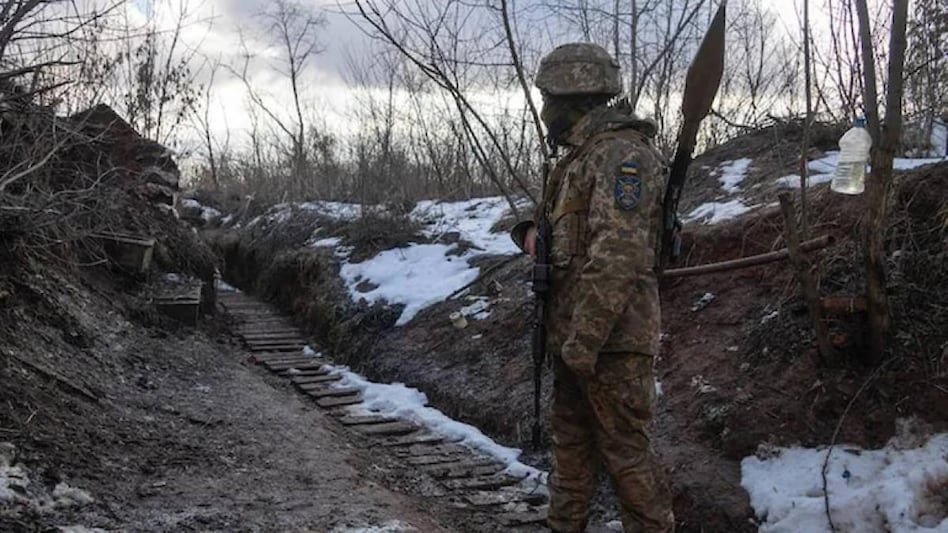In mid-January, Russia began moving troops to Belarus, a country bordering both Russia and Ukraine, in preparation for joint military exercises in February.

US officials ordered the evacuation of most of the US embassy personnel in Kiev on February 12, after they warned that a Russian invasion of Ukraine could come any day. President Joe Biden cautioned Russian President Vladimir Putin of the “sharp and serious” costs of any such attack.
Russia has accumulated an estimated 100,000 troops on its border with Ukraine over the past several months. The US has responded by sending several thousand troops to Ukraine’s two neighboring countries: Poland and Romania.
In mid-January, Russia began moving troops to Belarus, a country bordering both Russia and Ukraine, in preparation for joint military exercises in February.
Before the withdrawal of his military forces, Putin has issued several security demands to the US. Putin’s list includes a ban on Ukraine entering NATO and an agreement that NATO will withdraw troops and weapons from much of Eastern Europe.
There is a precedent for taking the threat seriously: Putin already annexed the Crimean part of Ukraine in 2014.
Ukraine’s layered history provides a window into today’s complex nation – and why it is under constant threat. As an expert on Eastern Europe, I highlight five key points to keep in mind.
What should we know about Ukrainians’ relations with Russia?
Ukraine gained independence 30 years ago after the collapse of the Soviet Union. Since then it has struggled to combat corruption and bridge deep internal divisions.
The western region of Ukraine generally favored integration with Western Europe. Meanwhile, the country’s eastern side favored closer ties with Russia.
Tensions between Russia and Ukraine peaked in February 2014, when violent protesters ousted Ukraine’s pro-Russian President Viktor Yanukovich, now known as the Revolution of Dignity.
Around the same time, Russia forcibly annexed Crimea. With a provisional government and an unprepared army, Ukraine was in a vulnerable position for self-defense.
Putin immediately went on strike in the Donbass region of eastern Ukraine. More than 14,000 people have been killed in armed clashes between Ukrainian government forces and Russian-backed separatists.
In contrast to its response to Crimea, Russia continues to officially deny its involvement in the Donbass conflict.
What do Ukrainians want?
Russia’s military aggression in the Donbass and annexation of Crimea has increased public support for Ukraine’s western flank.
Ukraine’s government has said it will apply for EU membership in 2024, and also has ambitions to join NATO.
Ukrainian President Volodymyr Zelensky, who came to power in 2019, campaigned on the platform of anti-corruption, economic renewal and peace in the Donbass region.
According to Ukrainian news site RBC-Ukraine, in September 2021, 81% of Ukrainians said they have a negative attitude about Putin. Just 15% of Ukrainians surveyed reported a positive attitude towards the Russian leader.
Why is Putin threatening to invade Ukraine?
Putin’s decision to engage in military formation with Ukraine is linked to the spirit of impunity. Putin also has experience dealing with Western politicians who advocate for Russian interests and join Russian companies after leaving office.
Western countries have imposed mostly symbolic sanctions against Russia over interference in the 2020 US presidential elections and a massive cyberattack against companies and about 18,000 people who work for the US government, among other crimes.
Without repercussions, Putin has backed Belarus President Alexander Lukashenko’s brutal crackdown on mass protests in the capital city of Minsk.
In many instances, Putin has seen some prominent Western politicians form an alliance with Russia. These alliances can prevent Western countries from building a unified front for Putin.
For example, former German Chancellor Gerhard Schroeder while in office advocated for strategic cooperation between Europe and Russia. He later joined as the chairman of Russian oil company Rosneft in 2017.
Other senior European politicians who have promoted a softer approach to Russia while in office include former French prime minister François Fillon and former Austrian foreign minister Karin Kneisel. Both joined the boards of Russian state-owned companies after leaving office.
What is Putin’s final game?
Putin sees Ukraine as part of Russia’s “sphere of influence” – a region rather than an independent state. This sense of ownership has prompted the Kremlin to try to prevent Ukraine from joining the European Union and NATO.
In January 2021, Russia experienced one of its largest anti-government demonstrations in years. Following his detention in Russia, thousands of Russians protested in support of political opposition leader Alexei Navalny. Navalny had recently returned from Germany, where he was treated for poisoning by the Russian government.
Putin is also using Ukraine as leverage for Western powers to lift their sanctions. Currently, the US has various political and financial sanctions against Russia as well as potential allies and trading partners of Russia.
A Russian attack on Ukraine could lead to more diplomatic negotiations that could lead to concessions on these sanctions.
The costs to Russia of attacking Ukraine would far outweigh the benefits.
While a full-scale invasion of Ukraine is unlikely, Putin could resume fighting between the Ukrainian military and Russia-backed separatists in eastern Ukraine.
Why would America want to join this conflict?
With its annexation of Crimea and its support of the Donbass conflict, Russia violates the Budapest Memorandum Security Assurance for Ukraine, a 1994 agreement between the US, the United Kingdom and Russia, which aims to protect Ukraine’s sovereignty, in return. In exchange for a commitment to give up your atom. Arsenal.
Putin’s threat against Ukraine comes as he is moving Russian forces into Belarus, which also raises questions about the Kremlin’s plans to attack other neighboring countries.
Military support for Ukraine and political and economic sanctions are ways the US can make it clear to Moscow that its encroachment on an independent country will have consequences.
The risk, otherwise, is that the Kremlin could take other military and political actions that would further jeopardize European security and stability.

